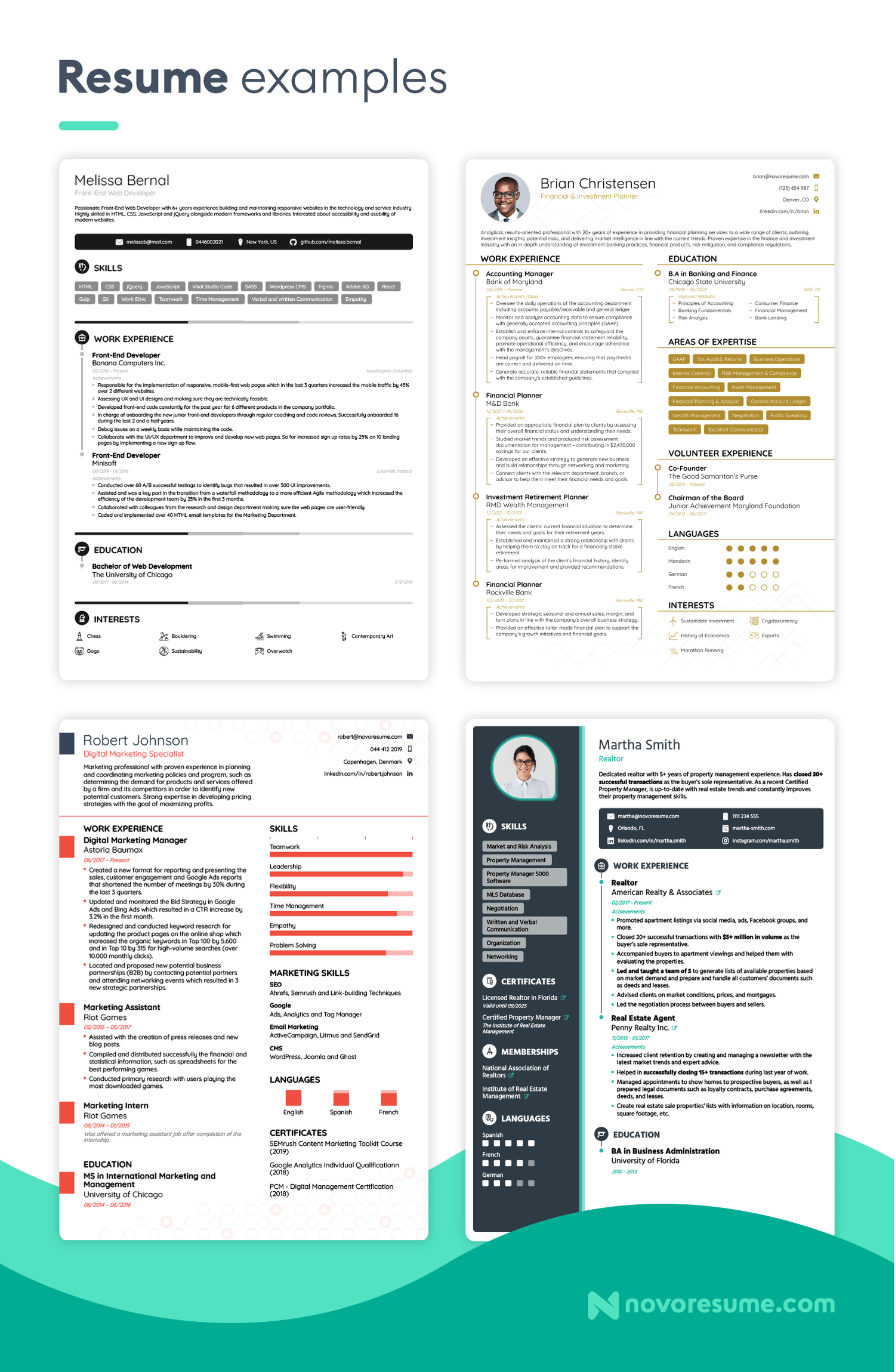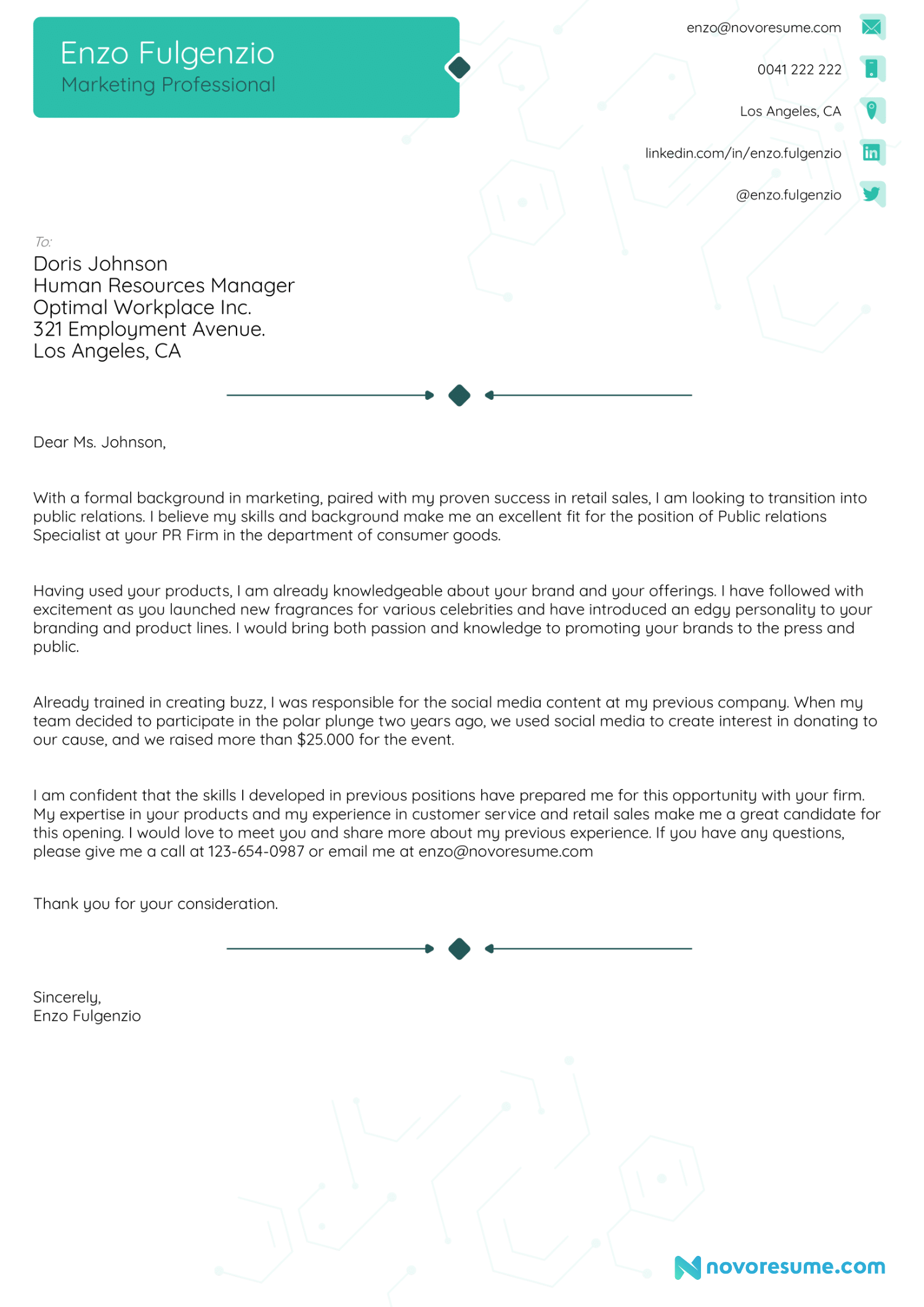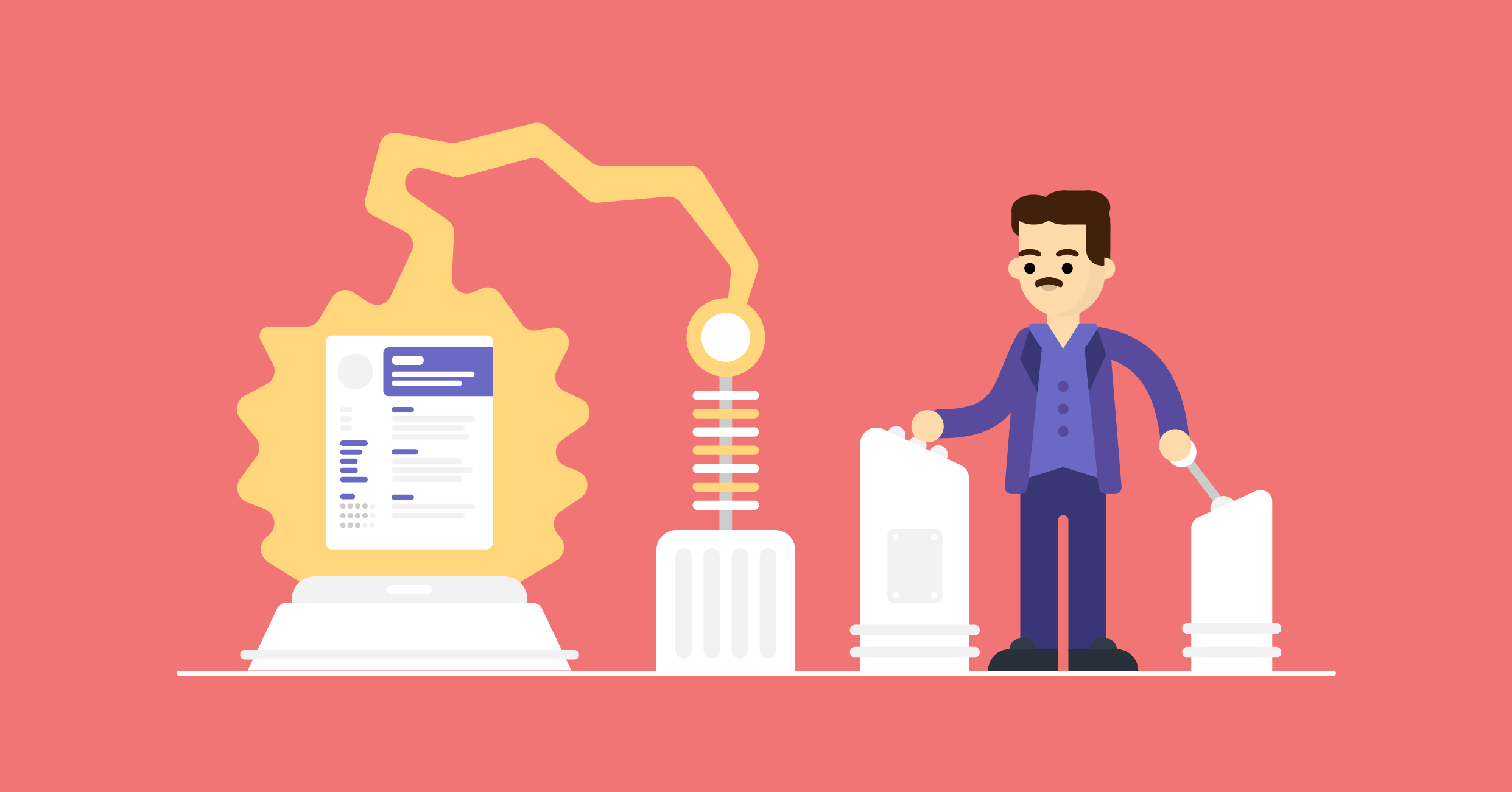Whether you’re a mechanical, electrical, civil, software, or chemical engineer, you’re great at solving problems.
And yet, when it comes to writing a job-winning engineering resume, you experience the equivalent of writer’s block.
You know you have the right skills, education, and work experience to land your next dream engineering position, yet you can’t seem to express all that effectively in your engineering resume.
And, for better or worse, a strong engineering resume is a prerequisite to land an interview and, eventually, land your next job.
Well, you actually have no reason to worry!
Writing a job-landing engineering resume that shows off your professional background is not hard and we’re here to guide you through the process.
So, in this article, we will cover:
- Engineering Resume Example
- How to Build Your Engineering Resume (Step-By-Step)
- 40 Skills For Your Engineering Resume
…and more!
Engineering Resume Example
If you were applying for a different position in this field, you might find one of our other resume examples more useful:
- Software Engineer Resume
- Artificial Intelligence Engineer Resume
- Computer Science Resume
- Data Scientist Resume
- Data Analyst Resume
- Data Entry Resume
- IT Resume
- Java Developer Resume
- Web Developer Resume
Here are the elements that make this engineering resume example outstanding:
- Reverse-chronological format. This resume format puts your engineering work experience in the spotlight AND is the most popular resume format around the globe.
- Contact information. The engineering resume example above includes relevant contact information, such as the candidate’s email address, phone number, LinkedIn profile URL as well as Skype handle.
- Resume summary. The engineering resume example above includes an engineering resume summary that briefly introduces the candidate and his areas of expertise.
- Achievement-focused work experience section. This engineering resume example includes the candidate's professional achievements, making his engineering resume stand out among other candidates’ resumes.
- Brief education section. In the engineering resume example above, the candidate only mentions his highest degree details, such as his Bachelor’s and Master’s degrees.
- Use of bullet points. The information in this engineering resume example is presented in bullet points to make the resume look well-organized and easy to skim through.
- Relevant engineering skills. The engineering resume example above mentions only engineering-related skills, including computer-aided design and project management.
- Use of additional sections. The candidate included relevant additional sections in the engineering resume example above, such as certificates and field-related interests.
How to Build Your Engineering Resume (Step-By-Step)
Now that you know exactly what makes an effective engineering resume, let’s put theory into practice and see how you can create a powerful engineering resume!
Here are the steps to building your engineering resume:
#1. Pick the Right Format For Your Engineering Resume
Before you start filling in the contents, let’s address how you should format your engineering resume.
Now, there are 3 resume formats you can choose from:
You’re best off using the reverse-chronological resume format for your engineering resume.
It’s the preferred resume format among recruiters worldwide, so it’s obviously the safest and most obvious choice for you!
And the best part? It starts off with your most recent - and relevant - engineering work experience, highlighting your achievements and skills first.
Here’s what it looks like:

Next, let’s talk about the resume layout.
Here are the guidelines for making a great resume layout:
- Pick a professional font style. Choose a font that’s easy to read on a PDF file and use it throughout the length of your engineering resume.
- Choose the right font size. Use 11-12 pts for the body and 14-16 pts for headings in your engineering resume.
- Bullet points. Whenever possible, use bullet points to present the information and make it easy for the recruiter to skim.
- Mind the length. Recruiters shouldn’t go through a 3-page resume to see whether you’re the right candidate, so the optimal length of your engineering resume should be one page (unless you’re a professional with 10+ years on the job, that is).
- Save your engineering resume in PDF format. Unless asked to do otherwise, your best bet is to save your resume as a PDF file to ensure it looks the same on every device and OS.
Use Our Tried & Tested Templates
As an engineer, you should use every opportunity to show the recruiter how innovative you are and your engineering resume is your first chance to do that.
Like most people, you probably tried creating a Word resume… admit it, using 30+-year-old software is the opposite of being innovative.
Think about it. You can spend hours on formatting alone, but in the end, your engineering resume will still look boring and outdated.
Well, what if we told you there is an easy way to save time AND stand out with your engineer resume?
Just use a resume template!
Our resume templates are created in collaboration with professional recruiters, so they don’t just look fresh and modern - they’re also well-organized and easy to scan.
Want to check for yourself?
Here’s how our resume templates compare to basic text-editors resumes:

#2. Add Contact Information
Now that the formatting is out of the way, you can start filling in the contents of your engineering resume.
Let’s start with the basics - your contact information.
You don’t have to invent anything new here - just make sure to avoid making any mistakes (you don’t want the recruiter to think you aren’t capable of successfully providing your contact information - after all, attention to detail is key to being an engineer!).
So, simply include the following details:
- First name and last name
- Professional title
- Phone number
- Email address
- Location
- Relevant social media profiles, such as LinkedIn
Here’s an example of the contact information section:
Sam Edwards
Mechanical Engineer
012-345-6789
Sacramento, California
linkedin.com/in/samedwards71
#3. Write an Engineering Resume Summary or Objective
After including your contact details, you should add a 2-3 sentence resume summary or objective to your engineering resume to quickly decide that your engineering resume is worth taking a closer look at.
Here’s how to choose which one to use:
- If you have lots of engineering experience, write a resume summary to highlight your skills and achievements.
- If you lack engineering experience, use a resume objective to show your career aspirations and how you can benefit the company.
First impressions matter, so whether you’re writing a resume summary or objective, it must effectively show your professional background or how you can be an asset for the company you’re applying to.
Otherwise, the recruiter might just move on to the next resume.
So, here’s what an impressive resume summary should include:
- Your position and years of experience
- Your most important engineering skills
- Your top 1-2 professional achievements
And here’s an example of an eye-catching engineering resume summary:
Driven and detail-oriented Electrical Engineer with 4+ years of experience with the design and fabrication of integrated circuits. Excellent troubleshooting, problem-solving, and analytical thinking skills. Solved a long-standing testing bug at Company X which increased the average testing time by 17%.
Now, if you don’t have the relevant experience and opt for a resume objective, this is what you need to include to make it as memorable as possible:
- Title of your engineering degree
- Any engineering-related experience
- Your motivation to work for the company
Specifically, it should look something like this:
Enthusiastic Software Engineering undergraduate student looking for an entry-level job at Company X. Experienced with Python, C++, and MATLAB programming languages. Looking to apply coding skills and creativity in educational game development.
#4. Make Your Engineering Work Experience Stand Out
Now, let’s move to the most important section of your engineering resume - your work experience.
First, let’s address the formatting.
Begin with your most recent/current job position and simply do this:
- Start off with the job title. This shows the recruiter what role you had in the company.
- Add company details. Include the name and location of the company you worked at. Optionally, you can briefly describe the company if it’s relatively unknown.
- Include the date of employment. Use the mm/yyyy format to write down how long you worked in each company.
- Add responsibilities and achievements. Use 5-6 bullet points for the most recent jobs, and 2-3 for older jobs.
Now that we’ve covered the basics, let’s talk about making the most out of your work experience section.
Of course, you want your engineering work experience to stand out among hundreds of other applications, so simply listing your responsibilities isn’t enough.
Luckily, you don’t need to reinvent the wheel!
Here are some tips to perfect your work experience section:
- Tailor your work experience section to the job. If you’re an engineer, your work experience section should show exactly that, so skip the barista job you had in university and use the space for your achievements or to include additional sections instead.
- Focus on achievements over responsibilities. Every civil, electrical, mechanical, or another type of engineer has the same responsibilities, more or less, but it’s your achievements that can really set you apart from the competition.
- Use action verbs to describe your achievements. Power words (e. g. developed, organized, operated, redesigned, assisted…) will spice up your engineering resume.
- Make your achievements quantifiable. Whenever possible, use numbers to drive the point home (e. g. “Led a team of 15 engineers” instead of “Led a team”).
And here’s an example of an effective work experience section:
Mechanical Engineer
Company X
02/2017 - 01/2022
- Worked with a team of 14 to design, build, and install industrial air compressors.
- Ensured compliance with safety rules and regulations.
- Increased production efficiency by 9% by strategically minimizing production bottlenecks.
- Planned and redesigned equipment layout to optimize workflow, resulting in a 7% production capacity increase over the span of 3 years.
- Consistently met the company's needs at 12% under budget.
What if You Don’t Have Work Experience?
Now, if you’re a fresh engineering graduate or haven’t graduated just yet, you likely don’t have relevant work experience.
That’s totally okay - even Elon Musk didn’t have enough relevant work experience at one point in his life.
But the lack of work experience shouldn’t set you back from building a powerful engineering resume!
You probably have more engineering-related experience to choose from than you think - after all, engineering studies typically involve lots and lots of practice.
So, instead of your work experience, consider including your internships, assistantships, academic projects, and merits, or extracurricular activities.
Here’s an engineering experience example:
Electrical Engineering Experience
Teacher’s Assistant for Electromechanics II
University of Bristol, UK
10/2019 - 03/2020
- Led problem-solving tutorials for 80+ second-year students.
- Created 10+ laboratory assignments for students using MATLAB Simulink and Adam Pluto transceivers.
- Took attendance, made questionnaires, and helped with other administrative work.
#5. List Your Education the Right Way
Nikola Tesla is a role model to many engineers.
As such, you probably already know he dropped out of university.
Of course, the lack of an engineering degree didn’t stop Nikola Tesla from becoming one of the greatest engineers, but today the situation is quite different.
Most engineering jobs ask for a Bachelor’s degree at the very least, because engineering is a highly technical field, where theoretical knowledge goes hand in hand with your practical skills.
But, even though your higher education is important to the recruiter, let’s face it - they don’t care which high school you went to.
So, instead of wasting space, make sure to only include relevant education details in your engineering resume.
To keep your education section short and snappy, start with your latest degree and include the following:
- Degree title
- University/college/other institution
- Program location (optional)
- Years attended
And here’s an example of the education section on an engineering resume:
Education
MSc in Electrical Engineering
Eindhoven University of Technology
10/2017 - 05/2019
Of course, you can also include relevant education details, such as your academic achievements, the courses you’ve taken, your GPA, projects, etc. - if they add value to your resume, that is.
#6. List Your Engineering Skills
Skills are an important part of your engineering resume. They testify to your professional abilities, so you should only include the skills which are relevant to engineering.
Now, although engineering is a technical job, you’re also expected to have a variety of soft skills.
After all, no engineer works in total isolation, so communication and teamwork skills are must-haves for most positions.
So, here are some tips to better organize the skills section on your engineering resume:
- Write your soft and hard skills separately.
- Your hard skills largely depend on the type of engineering you do (mechanical, electrical, software, etc.), so make sure to customize the skill section to fit your engineering resume.
- If you're unsure which skills to include in your engineering resume, you can always check the job ad and see if you have the skills the company is looking for.
Need more ideas on which skills to add to your engineer resume?
Check out our list of the 40 most in-demand soft and hard engineering skills!
Write down your hard skills as specifically as possible to give the recruiter a clear idea of your skills. For example, if you’re good at programming, make sure to include all programming languages (Python, C++, PHP, MATLAB, etc.) you know.
40 Engineering Skills to Put on Your Resume
25 Soft Engineering Skills
- Creativity
- Attention to detail
- Problem-solving
- Innovation
- Communication skills
- Teamwork
- Ability to work under pressure
- Curiosity
- Leadership
- Analytical thinking
- Active listening
- Prioritization
- Time management
- Leadership
- Emotional intelligence
- Organizational skills
- Adaptability
- Brainstorming
- Research
- Resilience
- Interpersonal skills
- Self-motivation
- Reliability
- Self-management
- Flexibility
15 Hard Engineering Skills
- Math
- Mechanical skills
- Project management
- Debugging
- Troubleshooting
- Prototyping
- Machine Learning
- Workflow development
- Web Development
- Computer skills
- Knowledge of manufacturing processes
- Knowledge of applicable laws
- Technical documentation
- PHP
- Data Structures
#7. Add Your Engineering Certifications & Licenses
Your university diploma is just one part of engineering training, so the next step is to include your engineering licenses and certifications.
This part is especially important if you want to work abroad because each country has different rules on what kind of education, licenses, and qualifications you need to work in engineering.
So, if you’re a certified or licensed engineer, list your licenses and certifications in your engineering resume in reverse-chronological order and include the following:
- Certification/license name
- Name of agency
- Year of obtainment
- Location (optional)
- Expiration date (if applicable)
- In progress (if applicable, and add the expected date of obtainment)
Here’s an example:
Professional Certificates
Certified Chemical Engineer (2019)
National Certification Commission in Chemistry and Chemical Engineering
#8. Make Use of Additional Resume Sections
Do you still have some space on your engineering resume?
Consider adding any of these additional sections to make your engineering resume stand out and paint the full picture of your engineering experience:
- Conferences, such as International Conference on Sustainable Energy Engineering, International Conference on Internet Technologies and Society, International Conference on Power Control and Embedded System, International Conference on Industrial Engineering, and others.
- Associations and organizations, such as engineering societies, including your role in them (if applicable).
- Awards, no matter if they’re company-wide or nationwide.
- Publications, such as studies, scientific articles, interviews, etc.
- Personal projects, if any of them are related to engineering.
- Languages, especially if you’re applying to a company overseas.
- Hobbies and interests, especially if they’re related to engineering.
And here’s what these extra sections should look like on your engineering resume:
Organizations
- Caspian Engineers Society (2018 - Present) - Board Member
Conferences
- Nanotech Eurasia 2021
- Nanotech Eurasia 2019
#9. Attach a Cover Letter to Your Engineering Resume
If you got this far, you’re just a step away from writing an effective engineering resume for yourself!
But before you get to it, there’s one more important element to your resume we need to address - writing a compelling cover letter.
The point of a cover letter is to convince the recruiter that you are the engineer they’ve been looking for.
Essentially, you need to prove you’re a competent engineer and a great match for the company, its values, vision, and goals.
So, your cover letter is a chance to give a detailed description of your engineering experience and include any important information that didn’t make it to your engineering resume.
But how exactly do you do that?
Actually, it’s quite simple with the right guidance!
Here’s how to write a job-winning cover letter:
- Include your contact details in the header.
- Address the cover letter directly to the recruiter.
- Grab the recruiter’s attention from the start by including your 1-2 top achievements in the first paragraph.
- In the body of your cover letter, give a detailed picture of your engineering background and explain why you want to work for this particular company.
- Lastly, end your cover letter with a call to action.
Want to make sure your cover letter is flawless? Check our cover letter writing tips and cover letter mistakes!
And here’s an example of a top-notch cover letter:

Want your cover letter to catch recruiters’ attention? Match it to your engineering resume by picking one of our cover letter templates!
Key Takeaways
Congrats!
By now, you have all the tools and tips you need to write an outstanding engineering resume (and a cover letter, too!).
Before you go, let’s go over some of the main elements of an impactful engineering resume:
- Choose the reverse-chronological format to focus your work experience and make your engineering resume easy to read.
- Write an impressive resume summary if you have plenty of work experience, and an eye-catching resume objective if you lack engineering experience.
- Make your work experience section stand out by quantifying your achievements.
- Show off your unique engineering experience with licenses, certifications, associations, publications, and other additional information that fits your engineering resume.
- Don’t forget to add a compelling cover letter to your engineering resume to prove you’re the perfect candidate and a great asset to the company.



